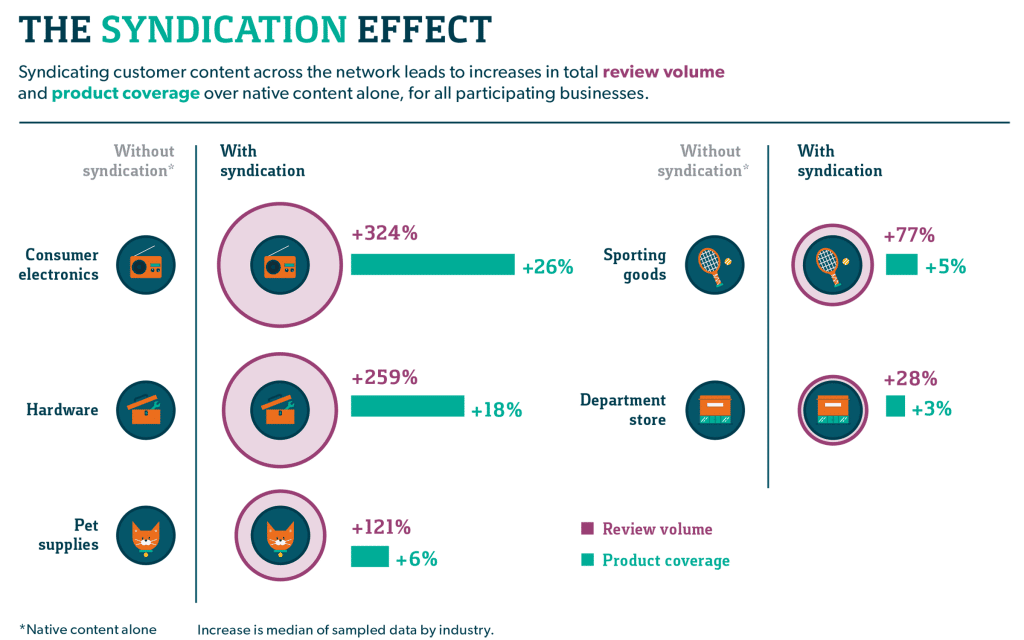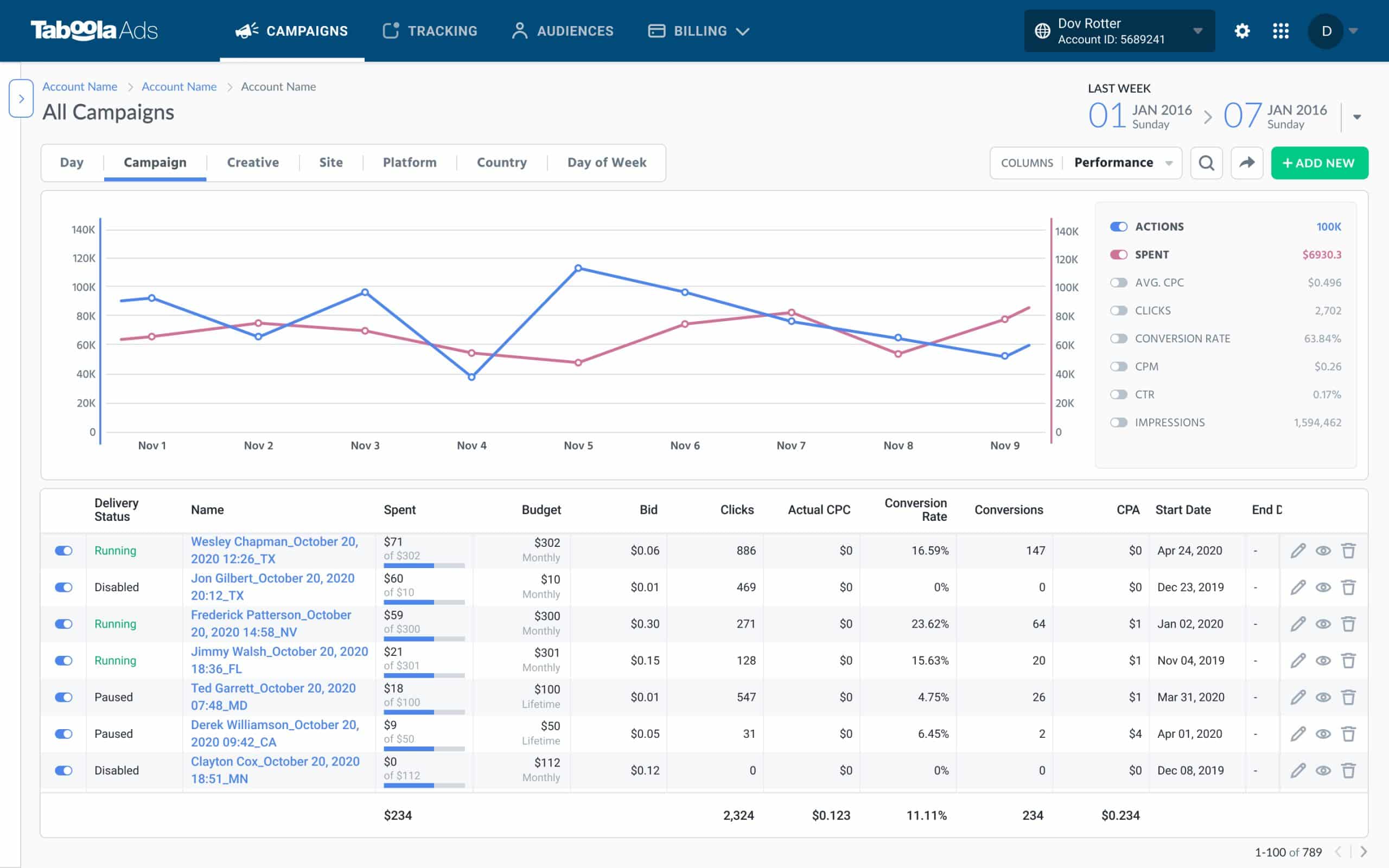
Why Content Syndication Is Part of an Effective Content Marketing Strategy
If you’re a content marketer, you know how important it is for you to have a variety of B2B marketing tactics up your sleeves. They can help you generate awareness around your brand, expand your reach, drive more sales leads, and so much more.
Syndicating content does a little bit of all that. When you syndicate things you’ve written or created, you’re distributing your content to third-party organizations so that they share or publish it on their platform.
If you’re not already syndicating your content in one way or another, you really should be. The online world is a big and cluttered place, so it isn’t reasonable to think that you can limit the distribution of your content solely to your own blog. It’s always a good idea to get your blog posts in front of a different audience, who would otherwise not even know it exists.
Key Takeaways
- Content syndication is about sharing your content on 3rd party sites
- It can include re-published articles or a service that generates leads by using whitepapers, e-books, research reports or recorded webinars
- Content syndication can be free or paid and should contribute to your overall marketing strategy
What is Content Syndication?
Content syndication is the sharing of original content on third-party platforms or sites that deem it valuable to their audience.
Content syndication can either be free or paid. Some websites and industry-specific news organizations are willing to re-publish your content on their site free of charge. Larger media sites often charge for sponsored content to be re-published on their sites for a fee.
An article content syndication network will help distribute your content on their affiliate sites and charge you each time your content gets clicked by visitors to the publishing site. On the other hand, those who clicked on your link will be taken to your website, where you can further engage them on their content journey.
The other type of content syndication that isn’t as well understood, is the use of whitepapers, e-books, research reports, or even recorded webinars on a 3rd-party website in order to generate leads. I’ve referred to these programs as pay-per-lead programs. But they’re often billed as part of a program that may or may not charge per lead and also may include guaranteed minimum leads.
If you google “content syndication” you see the first search results page full of article referring to this first type of content syndication where you re-publish articles on someone else’s site. But equally as relevant and much more measurable is the 2nd definition where you share gated content (registration-required) such as e-books or whitepapers in order to capture leads.
The Benefits of Content Syndication
Here are just some of the reasons why content syndication works as an effective marketing strategy:
Capturing a Wider Audience
Syndicating your content to authoritative sites with large, loyal audiences helps your content gain huge exposure among a larger audience than you might otherwise not have access to. Let’s say your original blog content has a potential reach of 1,000 content consumers, but that reach can go up to as many as hundreds of thousands on other sites.
If you have great content that’s giving you good engagement rates, repurposing that content gives you a valuable opportunity to target new audiences and demographics.
Whitepaper content syndication services may also provide access to industry or title-specific audiences.
Building a Consistent Online Presence
If you syndicate content on a regular basis, your brand becomes more visible and accessible digitally. It all starts from offering content that’s relevant and helpful for audiences, and following up with more content pieces that can help nurture your visitors throughout their content consumption journey.

Having a steady online presence can also help you close in on a niche that’s been proving to be a big challenge for your team. You only need to reach out to websites that have already established their authority in your line of business and let them help you showcase what you can offer through your content.
I’ve used content syndication in the past as part of an always-on marketing and lead generation strategy. This allowed us to see which content syndication campaigns worked best at capturing the highest quality leads. It also allowed us to assess which platforms provided the best leads so we could optimize our budget. Finally, since the timing of closed deals of most B2B purchases is well past 6 months, always-on programs allow you the time to measure results all the way to closed and won deals.
That’s something the sales team (and the CMO) loves!
Boosting Traffic
Article content syndication goals vary from business to business, but increased website traffic is almost always on the top 3 considerations of marketing teams. Remember, you need to drive traffic to your site before you can generate awareness about your brand.
Content syndication can boost your organic traffic for the simple reason that Google and other search engines equate specific syndicated content with quality and authority. For Google and others, the fact that credible news sites accepted your content means they see it as something that’s informative and valuable for their audience. From there, you can see higher rankings in search results over time.
Educating Customers
Once readers click on your content and reach your website, you can use that opportunity to give them more information about your brand or how your products can help solve their problems. Be sure to give them high-quality content where they can get great value in terms of the educational, newsworthiness, and entertainment aspects.
As a general rule, your content should only be 20% promotional. You might want to take note of these top four content types for your content syndication strategy: 85% whitepaper, 60% webcast, 50% infographic, and 35% articles.
Improving Lead Generation
Modern content marketing requires a focused strategy. When it comes to generating leads, it’s easier and more effective to find high-quality leads by distributing your content to publishers that target the same buyer personas as your brand. Like-minded audiences are more likely to be interested in your content, and indicates a good customer fit.
Syndicating content is a great way to improve your lead generation efforts because it amplifies your reach, allowing you to tap into an audience you might not have been able to reach otherwise. This helps you optimize returns and put your content in front of a relevant demographic with high buying potential, so you’re not restricted to your immediate audience of subscribers and loyal followers.
After all, you put a lot of time and effort into creating high-quality content, so it’s only natural that you’d want to expand your reach so that more prospects can benefit from your offer. This is where effective content syndication works like a charm.
On top of that, sharing your content improves your search engine performance through relevant backlinks and enhanced credibility. It also positions you as a thought leader in your industry. Ultimately, higher search placements help generate more traffic that could potentially result in more qualified leads.
Paid content syndication can also be useful, since most ad platforms usually facilitate audience-filtering options. For example, you can target prospects based on their demographics, device type, job title or role, company size, and industry type.
Increasing Brand Authority
Another benefit of syndicated content is that it helps you establish your brand or site’s identity as a subject matter expert.
When things get too crowded in your niche market, as they do very often nowadays, content syndication can help you differentiate your brand from other companies as you lock in your role as a thought leader—one who can inform and delight your audience as you talk about your brand, product, or service in a way that’s relevant and relatable to your desired audience.
What Content Syndication Is Not
Augmenting your original content through syndication, aggregation, and curation are crucial strategies marketers use to increase their target audience reach, as well as boost demand generation. While these terms are so closely related that they’re often interchanged, it’s important to note that each one is quite distinct.
Content syndication is the process of promoting your content on third-party websites as full articles, snippets, links, or thumbnails. The idea is to gain exposure and drive engagement by plugging your content into as many related digital contexts as possible.
Content aggregation, on the other hand, is the process of collecting content from different online sources for the purpose of reuse or resale. This can be done by a real person or via automated software, as the results are organized systematically based on various characteristics.
Content curation is similar to aggregation in terms of gathering content. However, it is different in that the content can also be original and the curation process is always executed using a person’s editorial skills and expertise.
Different Methods of Content Syndication
What are your options when it comes to syndicating content? There are various approaches you can take:
Co-Marketing: Co-marketing is when two companies collaborate on promotional efforts for a co-branded offer. Both companies promote a piece of content, which can be in the form of an ebook, whitepaper, research study, or any other gated content. Users are directed to a landing page where they can access the content upon providing their contact details. The resulting leads are then shared between the two companies.
Social Syndication: This technique is sometimes called “content swapping” and involves two brands agreeing to promote each other’s content on their own social media channels. This is a fairly simple and easy-to-implement strategy because sharing content on social media doesn’t take much effort. However, the opportunity for enhanced exposure makes this tactic hard to ignore.
Press Releases: Press releases distributed to various online media outlets, in some cases for free, and in other cases for a nominal fee. This content works best when your company has a new product available or some other piece of company news that your audience might find interest. It is written as a news-style article that links back to your brand’s website. Optimize press releases for lead generation by including links to an appropriate landing page where you can collect user contact information.
Guest Blogging: A guest blog is when an author creates unique content to be published exclusively on another brand’s website. It’s a great way to build backlinks and enhances your search placement online as well. Having said this, your main objective for guest blogging should be to drive relevant traffic and to build trust and authority for your brand. Backlinks should be acknowledged as a nice bonus.
Paid Article Syndication: For a fee, you can partner with a content syndication service to advertise or push your branded content onto specific sites. The service can also recommend your content on relevant websites that fit the demographic you want to target. Popular syndication networks include Outbrain, Zemanta, and Taboola.
Blogs That Publish Syndicated Posts: This is where brands approach relevant syndication sites to republish their content. It can either be done through an entire article, part of an article or an RSS feed. Popular marketing syndication sites include Social Media Today, and Mashable.
Whitepaper content syndication: This is where you republish your company’s original content, such as e-books, whitepapers, blogs, or videos on third-party sites in order to generate leads.
Content Syndication Networks to Check Out
Authoritative syndication networks can also up your content syndication game, as they can place your content on influential websites with high traffic or for targeted vertical leads. In turn, this could establish your brand as an equally authoritative figure on the subject matter, drive targeted visitors to your website, or quality leads to your sales team.
Content syndication networks are basically services that help you distribute your content across numerous news and blog sites on their network. Here are some of your options if you’re looking to syndicate your content and how they may be good (or not-so-good) for your business goals:
Outbrain

Outbrain is a popular content discovery and marketing platform that helps your readers find out about your content by recommending it to top media outfits like CNN, Time, and ESPN.
On its website, Outbrain states it’s reaching an audience of more than 550 million online users and serving them about 200 billion content recommendations per month. That’s how far your content could go on the Outbrain network. Outbrain also has features that let you track reader engagement so that you know which part or version of your content resonates well with your audience.
Zemanta

Zemanta is a programmatic content distribution platform owned by Outbrain. It utilizes automated bidding technology and artificial intelligence to optimize content to the right target audiences based on CPC or (if your analytics is integrated) cost per engaged visitors.
This is the platform we use to syndicate our client’s content to relevant platforms. We typically achieve significantly lower CPCs and higher engagement than industry standards.
Taboola

Taboola mostly serves high-end publishers including The NY Times, NBC, and CBS. Its content engine helps you determine which sites will give you the best engagement for your posts.
As of late, Taboola seems to be experiencing great success in marketing video content, so it’s best to consider the service if you see your brand doing more video content marketing in the near future.
Medium

Medium can be one of your best options for republishing content. It’s an online community that allows you to start your blog (if you haven’t any) right on the Medium site so that you get to share your content with interested people or organizations in its audience.
Many startups and brands who run their own blog also prefer to publish their content on Medium, as the platform is easy to use and link with their social profiles.
ActualTech Media

ActualTech Media helps the world’s largest technology marketers generate leads and pipelines for sales through whitepaper content syndication and webinar programs.
They deliver hundreds of thousands of targeted leads per year at highly affordable CPLs (cost per lead). And their team of experts can create the content for you.
Best Practices for Syndicating Content
There is no “best” way to syndicate your content. Try these different strategies to discover what works best for your brand and your particular target audience. Keep track of referral lead quantity and quantity to determine the best performing tactics to focus on.
Set Specific Goals
It’s already a given that you’re using content syndication to generate more leads by putting your content in front of a wider audience. But, it’s not enough to know that. You need to define the specifics of what exactly you’re aiming for. It’s best to identify your objectives down to the most granular level.
For example, are you looking for top of the funnel leads who will come from a more general audience or those who have already been identified as belonging to the middle of the sales funnel? Or is this a follow-up campaign directed toward Marketing Qualified Leads?
Drill down to what your goal is to help you decide on what your next steps will be, as well as what metrics you need to track and measure.
Align Your Content to Specific Stages of Your Sales Funnel
Knowing what your prospects require depending on which stage of the sales funnel they’re in will help inform the type of content you’ll want to utilize. For example, someone who’s in the later stages might be looking to make comparisons between their possible options so an educated decision can be reached.
In this case, a pricing or features comparison study would be appropriate and will get the best response. Those in the earlier stages of the funnel would most likely prefer topics that introduce a problem and discuss possible solutions.
It’s important to continue nurturing the relationship you started by following up with new leads. Keep them engaged by sending more relevant content their way to drive them along the sales funnel. When you send a follow-up email, make sure that you reference the content that was downloaded. Cap things off with another call to action that inspires loyalty and brand ambassadorship.
Don’t Compromise on Quality
Always come up with high-quality content that is crafted to resonate with your target audience and to help them in tangible ways. Provide something valuable and make it as informative, entertaining, and easy to digest as possible. Remember that your primary goals are to build authority and drive relevant traffic, so the quality of your syndicated content is critical.
Provide Gated Content that Compels Visitors to Act
If your content is accessible online, make sure that you can capture contact details and other relevant prospect information where possible. You can achieve this by linking your syndicated content to your gated content that requires prospects to provide contact details in order to access it.
Most readers generally prefer the following formats: e-books, case studies, research reports, webinars, whitepapers, worksheet templates, and checklists.
Choose the Right Syndication Partners
Companies and publishers with good reputations are always a safe bet when choosing which online platforms to push syndicated content to. While a large audience is helpful, it’s more important to go with a partner with the right type of audience that aligns with your brand. If your publisher can segment their audience in a way that allows your content to reach specific target markets, all the better.
Your partner may agree to republish your syndicated content or feature your original content (also known as guest post) on a one-off or regular basis. You can also agree on revenue sharing along these lines:
- Ad-Supported – In this method, you could get rewarded for writing great content by receiving a percentage of the syndication service’s advertising revenue.
- Licensed – Known as licensed blog syndication, this method allows you to earn money in the form of royalties whenever “high-quality” users discover and access your content.
As an additional step, get back to your syndication partner and have them share metrics about your content. Look at bounce rates, click-throughs, and other results to help refine your next strategy and improve your syndicated content in the future.
Read the Fine Print
Make sure that you take a close look at any syndication agreements you enter into with publishers. Remember that not all websites are reputable. Look for those that not only have a good reputation and online presence but a well-established content syndication program in place.
Pay for Content Syndication on Popular Sites or Mainstream Media
Reputable online publishers such as CNN, USA Today, Entrepreneur, and Forbes are usually an extension of their print counterparts or cable TV media giants. Since they are prominent names in the publishing world, these are excellent sites to re-publish your content and amplify your reach and exposure. They also typically charge you for their syndicated services.
The potential to drive traffic and awareness through these sites is enormous. If your content resonates with their readers, you have the opportunity to get exposure from prospective buyers who might otherwise not have heard of you. These readers could potentially become a regular part of your blog readership, and you’d be increasing your thought leadership with readers who have not heard of your brand yet.
Assess the Content Quality of Target Sites
It’s possible to have your content re-published onto a reputable website without having to pay for it. Numerous sites don’t charge anything to repost your content, depending on the industry you belong to. As long as you follow specific guidelines, in most cases, you can easily submit your content to obtain syndication services for free.
However, that doesn’t mean that you should go on a syndication spree and let random sites do the work of promoting all your blog posts (or any other content type for that matter) for you.
Reputable sites typically impose strict quality controls that you must abide by for your content to be published. Others only post content that fits their niche and target audience.
Syndicate to Sites with Greater Authority Than Yours
The credibility of the site that links to yours has the potential to give a positive boost to your site’s rankings. This is why you should see to it that you target only the best sites in your niche that Google recognizes as having actual authority. That website’s good reputation will help boost your own site’s authority and help increase your search rankings.
This borrowed authority will contribute to improving your SEO, get more people to see your content, and attract a new source of readers to your own site. The more you come up with quality syndicated content that new readers can resonate with, the more it amplifies your exposure, attracting new audiences, building authority and fostering brand trust.
Keep in mind though, when you’re syndicating content on high authority sites, the quality of your content has to match their potentially high standards.
Select Relevant Content for Syndication
It bears repeating that the content you submit for syndication must match the interests of that website’s audience. So take the time to find out what topics and types of content will truly resonate with the readers that you’re trying to target.
You’re building your reputation with a site that most likely has a higher authority than yours (if you’re doing it right), so you should put your top content forward and syndicate the best you have to offer.
Put Out Enough Content Frequently
In this case, the more, the merrier. The more content you syndicate, the higher your potential lead volume. This, in turn, improves your ability to meet lead targets at a more efficient rate. Just make sure that you’re keeping enough unique content to publish on your website. Otherwise users won’t have a good reason to visit.
The only additional cost for providing more syndicated content is the time spent creating the content to syndicate. Explore which types of content get the best reception from different channels. Whether its eBooks, videos, webinars, infographics, or white papers, pay attention to which types of content generate the most leads and decide what to focus on from there.
Write Enticing Abstracts
An abstract is typically about 200 words long and is used to describe the content you’ve shared on a website. It is a great alternative to click-bait headlines.
By the way, you should ALWAYS be varying and testing your headlines with the content that you syndicate.
Many fall into the trap of writing abstracts in an uninspired manner, which is a great strategy if you want readers to ignore the great content you’ve created.
To encourage clicks, you should write an abstract that inspires whoever reads it. You can do this by describing the value of the content and perhaps some key selling points. Use action words like “learn” or “find out more” to ensure that readers know exactly what to do next.
Don’t Let Search Engines Confuse Your Syndicated Content with Duplicate Content
If you’re not careful, you might make the mistake of creating duplicate content when trying to get your posts syndicated. You should know that search engines penalize websites for having content that isn’t unique and original, so take every precaution to prevent that from happening.
There are three common ways to ensure that your republished work is not regarded as duplicate content:
- Rel=Canonical:
Placing the “rel=canonical” tag on your syndicated content will ensure that it points back to the original post located on your website and attributes all associated authority to the source. This tag tells search engines that you are the original publisher and that the syndicated content is just a copy.
- NoIndex:
Using the “noindex” tag on the syndicated copy tells the search engines that the republished content should be kept out of the directory and that automated bots should avoid indexing the page.
- Direct Attribution Link:
A third option is to get a link back from the syndicated copy directly to the original content on your website. Note that the link should point to the actual article and not just your home page.
Use Content Syndication Software
There’s a lot of automation software and martech tools around that help you amplify your syndicated content to reach as many readers as possible. If you’re still doing it manually via multiple online platforms, you’re missing out on the ease and convenience that these readily available tools bring to the table. They’ll also save you from endless hours of searching for syndication opportunities.
Follow Up on Leads
If your syndicated content manages to drive prospects towards your sales funnel, you should act quickly. As the saying goes, you must strike while the iron is still hot! See to it that you institute a timely lead follow-up strategy after capturing those leads.
Every one of them should immediately receive a welcome email after they appear on your prospect list. This is to ensure that leads are acknowledged, and there are no missed opportunities for turning a lead into a paying customer.
Content Syndication Is Here to Stay
As you can see, content syndication can give your marketing strategy a lot of mileage. It generates all of the good stuff in marketing—from brand recognition, audience engagement, leads, potential sales, industry leadership, and more. If you publish quality content on a consistent basis, don’t let it go to waste by not sharing it through syndication. It is one of the best ways to increase your brand’s online visibility and enhance your reputation.
If you’re just starting out, a more aggressive approach might be advantageous so you should take every opportunity for content syndication, targeting high authority sites as much as possible. If you already have a more established reputation, then you can afford to be more selective about where you’ll be republishing your content.
So yes, content syndication is and will always be an effective marketing strategy. You need to maintain a good balance with original content and also include curated posts in the mix to sustain engagement and keep visitors interested. The key is that there should always be a clear value proposition (that is tied to one of your strategic goals) behind your content offering.






